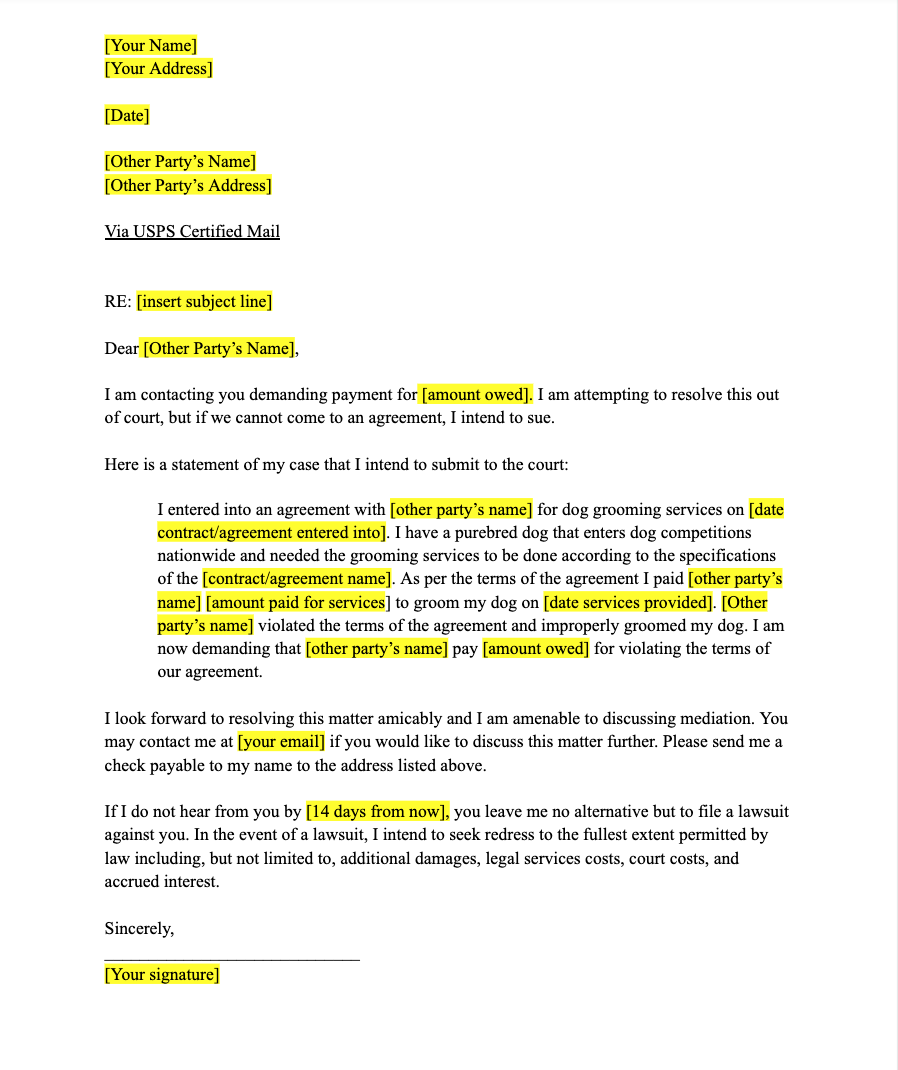Contents
Sent a demand letter but didn't receive a response? Even though your demand letter was likely well thought-out and discussed possible settlement offers, the other party ignored you. Now what?
In this article, we will review:
How to send a final demand letter
How to sue in small claims
Looking to send a demand letter? Request an attorney demand letter or use our free demand letter template to write one.
Get Started ➜What Happens After a Demand Letter is Sent? 
Below are the three possible outcomes of sending a demand letter:
The other party responds and meets your demands. This would be the ideal scenario and would mean you can avoid going to court to resolve the dispute. Try to write down any settlements and get the other party’s signature on the written settlement document in case the other party decides to back out later.
The other party responds but would like to discuss it further. It could be the case that the other party wants to iron out the details of the settlement or payment plan you have offered them. Continue to discuss the matter via phone or in mediation. Mediation involves you, the other party, and a neutral third party called a mediator. The mediator will help facilitate a settlement both you and the other party are okay with.
The other party ignores the letter or refuses the terms of the letter. It could be that the other party receives your demand letter but does not respond to your requests or outright refuses to meet your demands. If this happens, consider the options below.
Reasons You Might Not Have Received a Response to Your Demand Letter
Here are some common reasons why an individual or business might ignore your demand letter:
Your demand letter did not clearly state what you intended to sue for and why you are owed payment. For example, you send a demand letter that only asked the other party to pay you $1,000 without explaining the grounds for your demand.
You used threatening or disparaging language in your demand letter. For example, you called the other party a conman or liar and soured your chances of reaching a settlement.
Your demand was unreasonable or too high. For example, you intend to sue your contractor for improperly installing new windows worth $500. However, in your demand letter, you asked the contractor for $1,000. Unless you have a basis for this higher amount, it is not likely the contractor will give the demand letter a second thought.
Sample Demand Letter Template 
Here is a video on how our free demand letter tool works:
Below is a sample demand letter template we suggest reviewing. This template involves a breach of contract. Maybe your demand letter was ineffective because it missed the main section explaining why you are demanding payment or because you needed to give the other party more specific settlement terms. Take a look at the template below and compare it to the demand letter you sent. Maybe it is worthwhile to send another demand letter to the other party that resembles this template.

View more sample letters here.
With our letter service, we ship your letter for you using Certified or Priority Mail.
Get Started ➜What to do if the Demand Letter Doesn't Work?
If you sent a demand letter but still have not resolved the dispute consider the two options below:
Below we will discuss both of these options.
Send a Final Demand Letter
Consider sending a final demand letter if you have already sent a demand letter to the other party. The party may just need one final notice or another opportunity to consider settling the dispute. For example, if you are a business owner, sending a final demand letter before legal action can be a very useful tool if you are trying to collect past-due invoices from clients.
Learn how to write a final demand letter before taking legal action.
Sue in Small Claims Court
If you sent the other party a demand letter (and a final demand letter) and are still unable to resolve your dispute you may want to consider suing them in small claims court (review our 50-State Guide to Small Claims). Small claims courts handle various types of cases at a low cost. This is because small claims courts were intended to be affordable and user-friendly. In some small claims courts, attorneys are not even allowed to represent you! Consider filing a small claims lawsuit if you are not able to settle your dispute outside of court.
Common types of small claims lawsuits
Small claims courts handle a wide variety of cases. You can sue in small claims court so long as there isn't another court better suited to hear the case. The most common types of small claims cases are:
Disputes between individuals over money owed. For example, you lent your work colleague money to pay off their debt and they won’t pay you back.
Breach of contract disputes. For example, you enter into a service contract with a service provider and they never perform.
Disputes between two drivers after a car accident. For example, you were driving your car and got into an accident that lead to property damage to your car.
Disputes between homeowners and contractors over remodeling or home repairs.
Disputes between individuals over property damage. For example, your neighbor's tree branch fell on top of your car and severely damaged it.
Disputes between a business owner and clients over outstanding invoices.
Disputes between landlords and tenants over the security deposit.
Disputes between landlords and tenants over unpaid rent.
Learn how to file a small claims lawsuit in NYC small claims and California small claims.
We can help you with a demand letter. Request an attorney demand letter or write a demand letter using our free tool.
Create Demand Letter ➜
Camila Lopez, Esq.
Attorney at JusticeDirect. Camila holds a law degree and is a certified mediator. Her passion is breaking down complicated legal processes so that people without an attorney can get justice.

